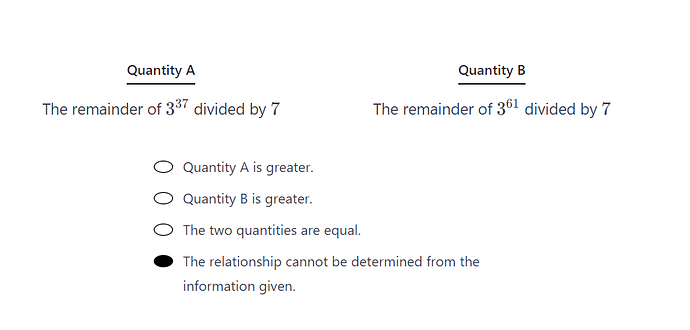Hi, I have a problem in the related homework to this topic in PrepSwift. In the attached image, we have 3^37 and 3^61 . Firstly, as I checked the solution, why it went down to 3^7 ? always in the video it was told to calculate up to ^4 to find the pattern so I didn’t get this one! Secondly, 61 , its previous number is 60 which is the multiple of all 2,3, 4 and even 6. So how do I decide which number to use for finding the remainder? in the solution it focused on 6 but as I mentioned earlier, I still can’t get why it continued up to 3^7 instead of only up to 3^4!
Hello again, is there anyone to help me with this issue?
Try writing down the remainders for the first few powers of 3.
Are you saying that we need to continue calculating powers until we identify a pattern? For the next part, could you explain the section in the attached image? I’m confused about why we focus on the number 6 and why it’s unnecessary to continue further. If there were another number where we should apply this strategy, what would that approach look like? It seems like this example skips some important steps.
Generally, yes.
Try with the next few powers - do you see the pattern? In a past problem, it might have been enough to look up to 4 as the pattern repeats every four times; it is not so here.
Yes, I understand that to identify the pattern, we needed to go beyond 4 this time. My second question pertains to the next step after discovering the pattern: how do we find the remainder? The solution methodology mentions using division by 6, but it also states that this step can be skipped. What does this mean? Why were we able to skip it this time, and if we couldn’t skip it, what would the strategy have been?
The idea is to find the remainder when you are finding the pattern (i.e, what is the remainder when 3^1 is divided by 7, the remainder when 3^2 is divided by 7, and so on).
Where does it say that?
In the previous messages, I attached an image highlighting a specific part. After identifying the patterns based on the remainders, we now need to determine how 37 and 61 align with this pattern, correct? My confusion lies here: do we focus on 6 because 36 and 60 are multiples of 6? But why not use 4? After all, 36 and 60 are also multiples of 4. We could consider the remainder for 3^37 and 3^61 to be 5 instead of 3. I don’t understand why we choose 6 for comparisons when other numbers, like 4 in this case, could also serve as a logical basis.
No, because the pattern repeats with period 6. For instance:
- the remainder when 3^1, 3^{7}, 3^{13} and so on is divided by 7 is the same,
- the remainder when 3^2, 3^{8}, 3^{14} and so on is divided by 7 is the same,
and so on.
ooh! Got it! thank you so much!
Hi, thank you for the explanation as to why we go beyond 4.
- So how do we know if we should look at the intervals in which the pattern repeats or simply identify which number (out of the first few, 0,1,2,3,4,5,6,…) the exponent of the divisor is a multiple of?
- Why are we asked to look at what remainder 37 and 61 have when divided by 6? Is the only way to know this by seeing the interval of pattern repetition? why didn’t we do this in other questions
By default, this is the route.
It follows from the first approach - look at the pattern to determine which multiple you need to consider.
Indeed.
Which ones?
Thank you for your response!
I understand now. I thought we were looking for a number closest to the exponent which is a power of 4 and working forwards or backwards from there. But it just happened to be the multiple of 4 because the intervals were 4 there. the interval need not always be 4 and where it is different, that interval will determine the multiple we look at. here, the interval being 6 meant we looked for 36 and 60. would that be right?
Yes.

